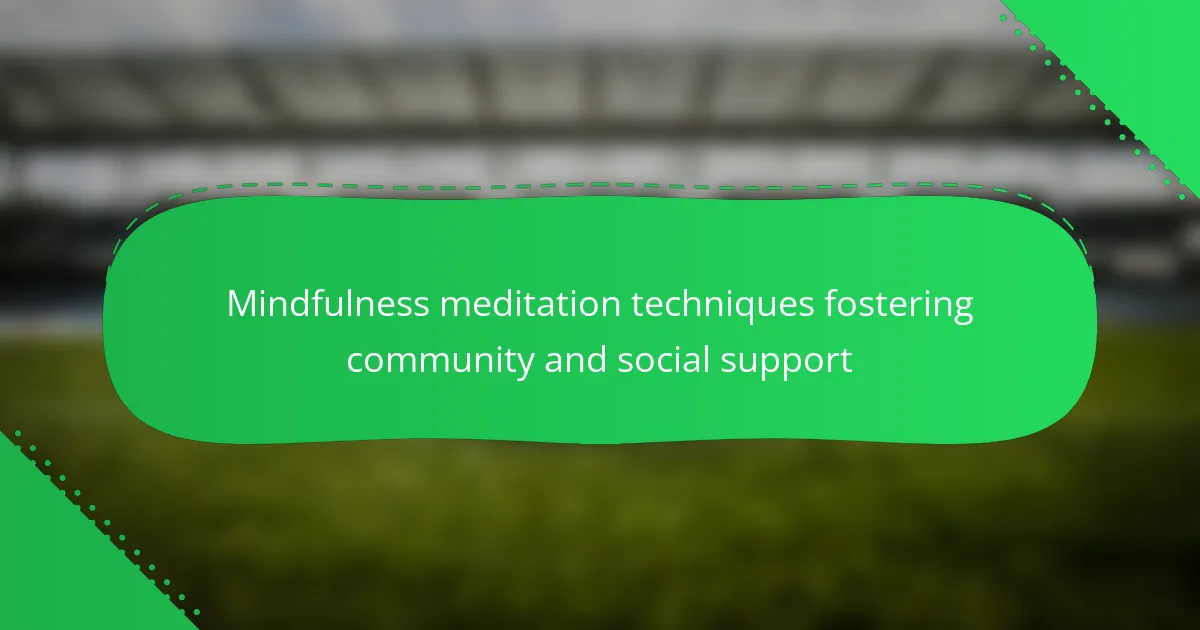Mindfulness meditation techniques foster community bonding by enhancing social support and emotional resilience. Group sessions create shared experiences, promote open communication, and build trust among participants. Techniques like loving-kindness meditation specifically encourage compassion, while mindful listening cultivates belonging. Addressing challenges, such as access to trained instructors, is crucial for effective implementation in diverse communities.
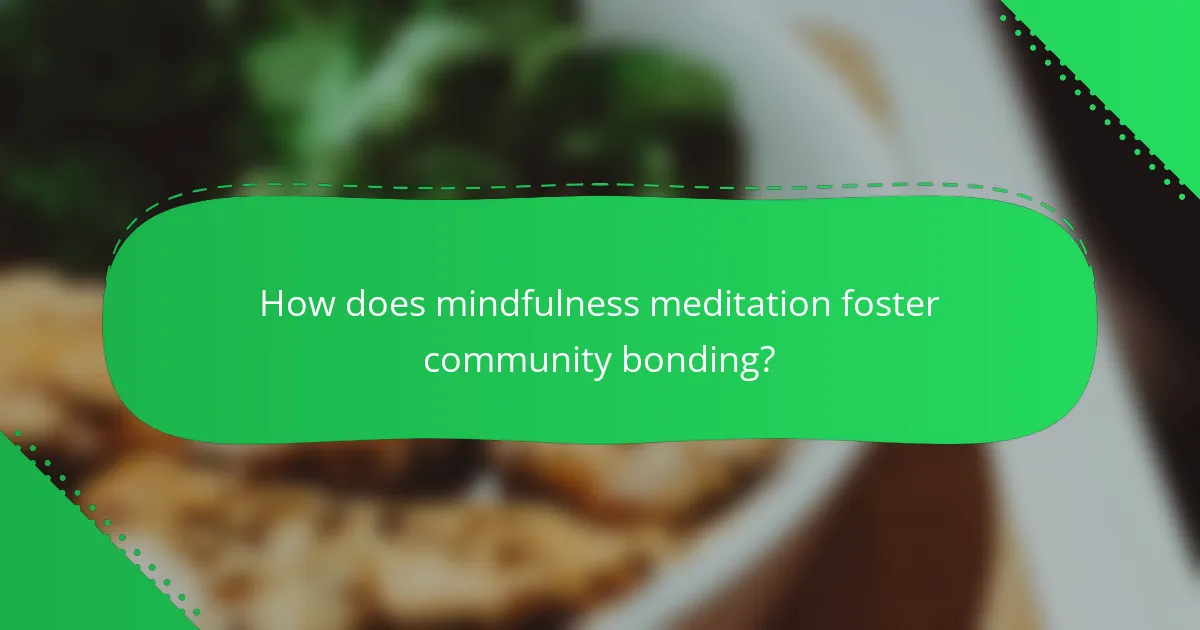
How does mindfulness meditation foster community bonding?
Mindfulness meditation fosters community bonding by creating shared experiences and enhancing social support. Participants often engage in group meditation sessions, which build trust and empathy among members. This practice encourages open communication, allowing individuals to express thoughts and feelings without judgment.
Research indicates that group mindfulness sessions can lead to stronger social connections, as participants report feeling more understood and supported. The collective focus on mindfulness creates a sense of belonging and reinforces community ties. Additionally, mindfulness techniques, such as loving-kindness meditation, specifically promote compassion and kindness towards others, further strengthening bonds within the community.
What social benefits arise from group meditation practices?
Group meditation practices foster community and social support by enhancing interpersonal connections and reducing feelings of isolation. Participants often experience increased empathy, trust, and collaboration, creating a supportive environment. Shared mindfulness experiences can lead to stronger group cohesion, promoting collective well-being. In addition, group meditation can facilitate the development of shared goals and values, reinforcing social ties within the community.
Which mindfulness techniques are most effective for building social connections?
Mindfulness techniques that effectively build social connections include loving-kindness meditation, mindful listening, and group meditation practices. These techniques foster empathy, enhance communication, and create supportive environments.
Loving-kindness meditation encourages practitioners to cultivate feelings of compassion toward themselves and others, strengthening interpersonal bonds. Mindful listening promotes active engagement in conversations, which deepens understanding and connection. Group meditation practices create a sense of community, allowing participants to share experiences and support one another.
Research indicates that consistent practice of these techniques can lead to increased social support and improved relationships, highlighting their effectiveness in fostering community.
How do cultural variations influence community engagement in meditation?
Cultural variations significantly influence community engagement in mindfulness meditation by shaping practices and social dynamics. Different cultures may emphasize collective participation, fostering social support through group sessions. For instance, in Eastern traditions, community-oriented practices often include rituals and shared experiences that enhance connection. In contrast, Western approaches may focus more on individual benefits, potentially limiting communal engagement. Understanding these cultural nuances can enhance the effectiveness of mindfulness meditation programs, ensuring they resonate with diverse communities.
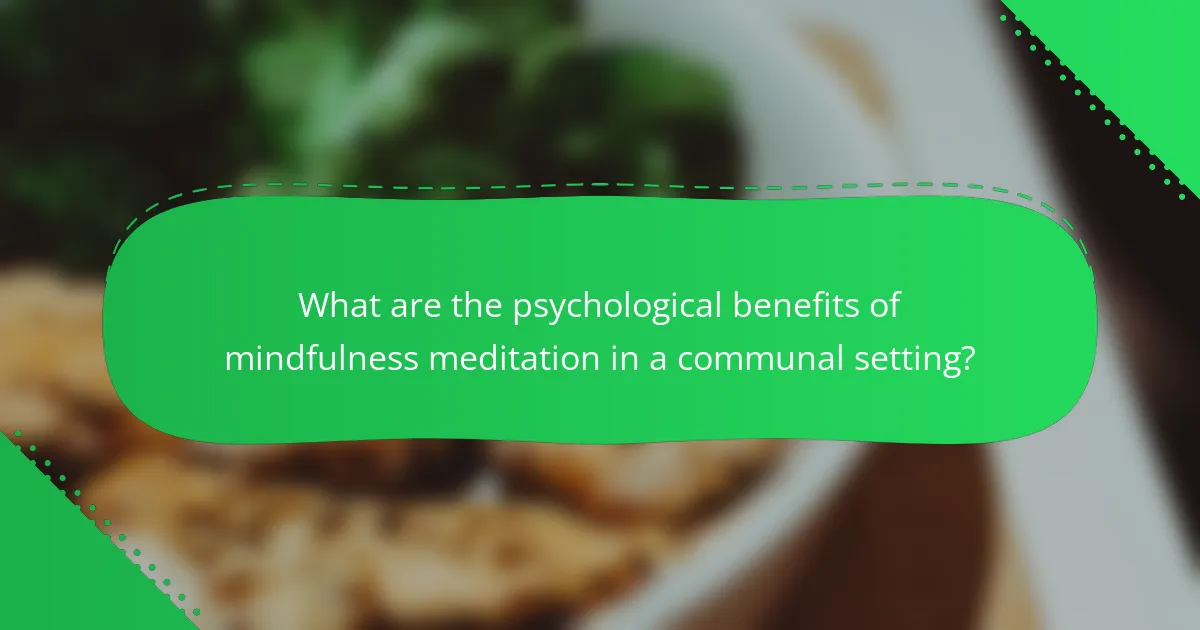
What are the psychological benefits of mindfulness meditation in a communal setting?
Mindfulness meditation in a communal setting enhances psychological well-being through social support and shared experiences. Participants often report reduced stress, improved emotional regulation, and increased feelings of belonging. These benefits stem from collective mindfulness practices that foster empathy and connection among individuals. Research indicates that group meditation can amplify positive psychological outcomes, as communal environments create a supportive atmosphere conducive to personal growth.
How does mindfulness meditation enhance emotional support among participants?
Mindfulness meditation enhances emotional support among participants by fostering a sense of community and shared experience. Participants develop stronger connections through group practices, which promote empathy and understanding. This shared journey reduces feelings of isolation, enabling individuals to express emotions freely and receive support. Research indicates that mindfulness can increase emotional resilience, allowing participants to cope better with stress and adversity, further strengthening communal bonds.
What role does shared experience play in strengthening community ties?
Shared experiences in mindfulness meditation significantly enhance community ties. They create a sense of belonging and mutual support among participants. Engaging in group meditation fosters emotional connections, as individuals share their journeys and insights. This collective practice cultivates trust and empathy, essential for strong community bonds. Research indicates that communities with shared mindfulness practices report higher levels of social support and cohesion. As a result, these communities become more resilient and better equipped to face challenges together.
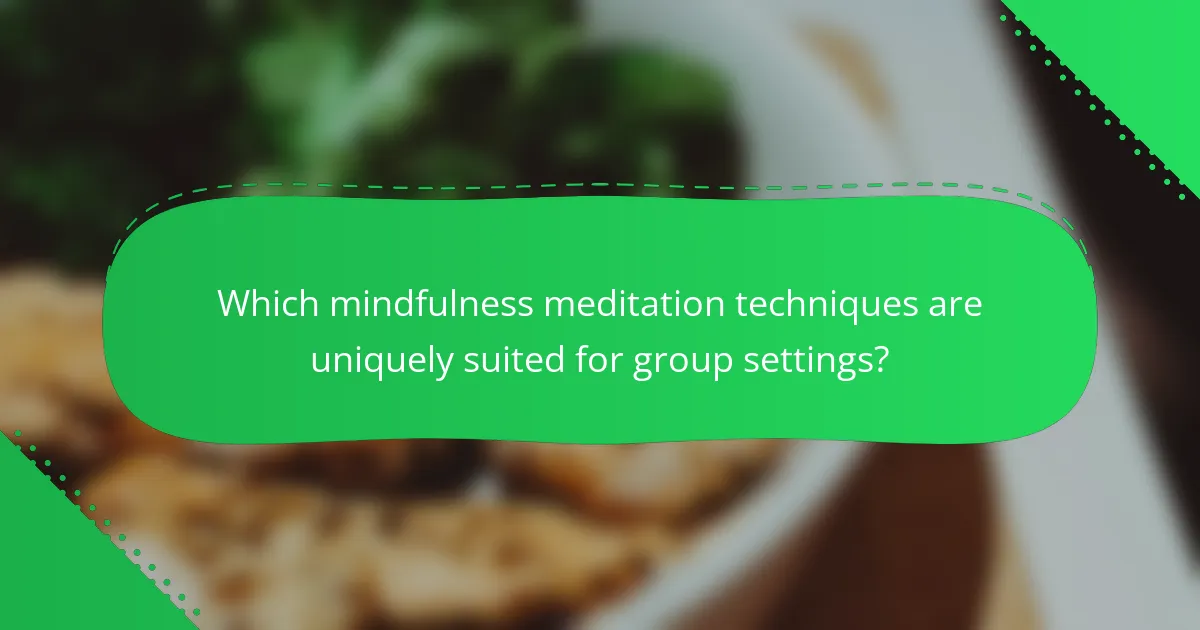
Which mindfulness meditation techniques are uniquely suited for group settings?
Mindfulness meditation techniques uniquely suited for group settings include guided meditations, group discussions, and partner exercises. These approaches enhance social support and community bonding. Guided meditations allow participants to experience shared focus, fostering connection. Group discussions encourage sharing insights, promoting collective growth. Partner exercises build trust and deepen interpersonal relationships, creating a supportive environment.
How does guided meditation differ from solo practices in a community context?
Guided meditation fosters deeper community connections compared to solo practices. It offers structured support and shared experiences that enhance mindfulness and social bonds. Participants benefit from collective energy, accountability, and the opportunity to discuss insights, which strengthens the overall practice. This communal aspect can lead to improved mental health outcomes and a sense of belonging, making the experience more enriching than solitary meditation.
What are the unique attributes of community-based mindfulness programs?
Community-based mindfulness programs uniquely emphasize social connection and collective well-being. They foster shared experiences, enhancing emotional support among participants. These programs often incorporate diverse cultural practices, making mindfulness accessible to various communities. Additionally, they frequently adapt to local needs, promoting inclusivity and engagement.
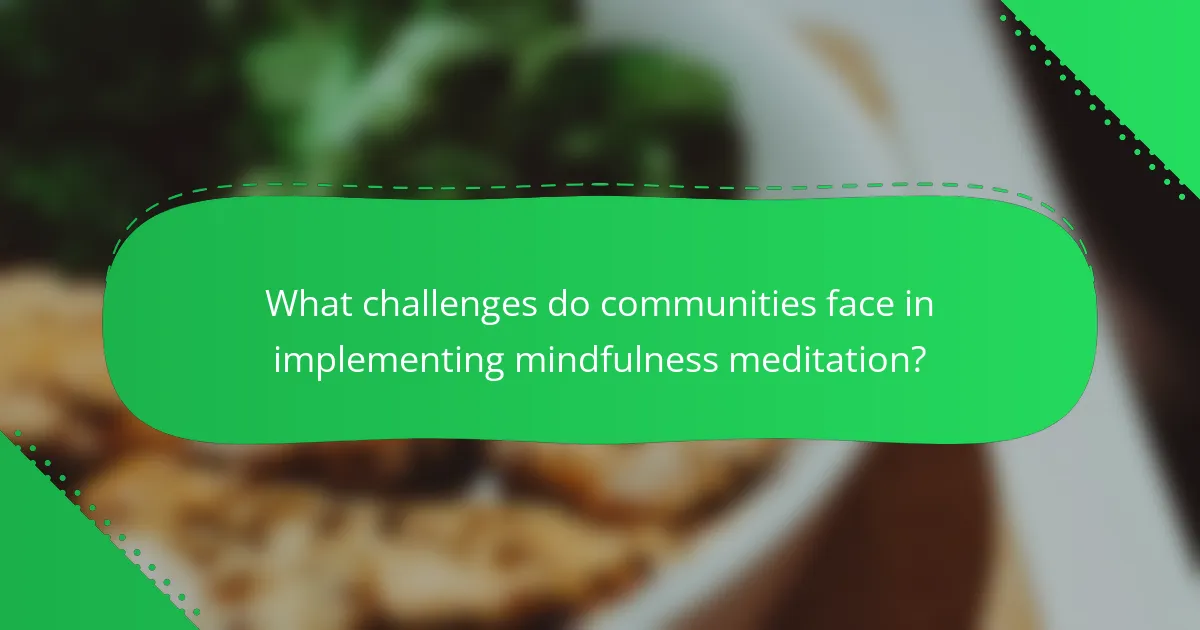
What challenges do communities face in implementing mindfulness meditation?
Communities face several challenges in implementing mindfulness meditation, including limited access to trained instructors, cultural resistance, and inadequate funding. These obstacles hinder the establishment of effective programs that foster social support.
Limited access to trained instructors can restrict the quality and availability of mindfulness programs. Cultural resistance may stem from misconceptions about meditation, viewing it as an individual practice rather than a communal one. Inadequate funding often results in fewer resources for outreach and program development, making it difficult to engage diverse community members.
Additionally, varying levels of interest and commitment among community members can complicate implementation efforts. Some individuals may struggle to integrate mindfulness practices into their daily routines, leading to inconsistent participation. Addressing these challenges requires a collaborative approach that emphasizes community involvement and resource allocation.
How can barriers to participation be addressed in diverse groups?
Barriers to participation in diverse groups can be addressed through mindfulness meditation techniques that promote inclusivity and social support. These techniques foster a sense of belonging and understanding among participants.
Implementing group sessions can enhance community ties. For example, guided meditations can be tailored to reflect cultural backgrounds, ensuring everyone feels represented. Additionally, creating safe spaces for open dialogue encourages sharing of personal experiences, which strengthens social bonds.
Regular practice of mindfulness can improve emotional regulation, making participants more empathetic and responsive to others’ needs. As a result, this shared practice cultivates a supportive environment where individuals feel empowered to engage actively.
Incorporating feedback mechanisms allows for continuous improvement of the meditation programs. This adaptability ensures that the techniques remain relevant and effective for all participants, thus reducing barriers to involvement.
What strategies enhance inclusivity in community meditation sessions?
Inclusive strategies for community meditation sessions include creating a welcoming environment, promoting diverse participation, and encouraging open dialogue. Establishing a comfortable space fosters connection. Offering guided sessions that incorporate various cultural practices enhances engagement. Facilitating group discussions allows participants to share experiences and support each other. These approaches build a sense of belonging and community support in mindfulness practices.
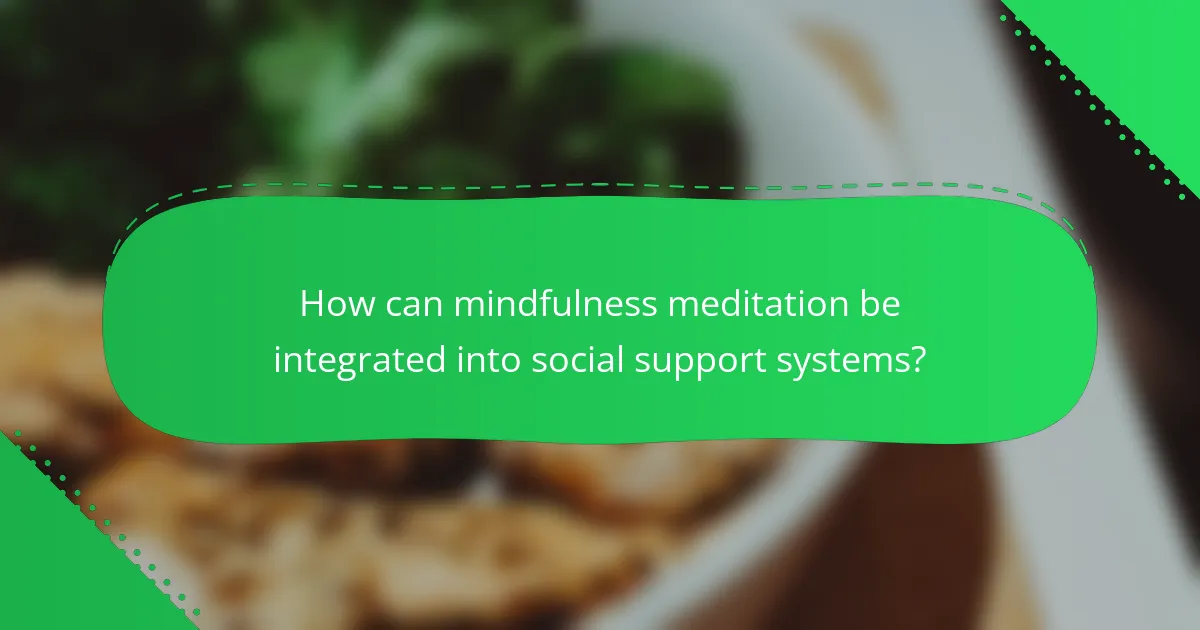
How can mindfulness meditation be integrated into social support systems?
Mindfulness meditation can enhance social support systems by promoting emotional resilience and fostering community connections. Techniques such as group meditation sessions and mindful listening cultivate a sense of belonging. These practices encourage open communication, empathy, and shared experiences, which strengthen interpersonal bonds. Research shows that participants in group mindfulness activities report higher levels of social support and lower stress. Integrating these techniques into community programs can lead to improved mental health outcomes and a more supportive environment.
What are the best practices for incorporating mindfulness into community health initiatives?
Incorporating mindfulness into community health initiatives enhances social support and fosters connection. Best practices include establishing regular group meditation sessions, promoting mindfulness workshops, and integrating mindfulness into existing community programs.
Additionally, leveraging local leaders to guide mindfulness practices can increase participation and engagement. Creating a supportive environment through shared experiences strengthens community bonds. Evaluating participant feedback helps refine these initiatives for better impact.
Which organizations lead successful community mindfulness programs?
Organizations leading successful community mindfulness programs include the Mindfulness-Based Stress Reduction (MBSR) program, the Center for Mindfulness in Medicine, Health Care, and Society, and the Mindful Schools initiative. These organizations focus on fostering social support through mindfulness meditation techniques. MBSR, developed by Jon Kabat-Zinn, emphasizes reducing stress and promoting well-being. The Center for Mindfulness offers training for healthcare professionals, enhancing community health. Mindful Schools provides mindfulness education for children, improving emotional regulation and resilience. Each organization contributes uniquely to community mindfulness by tailoring programs to diverse populations and settings.
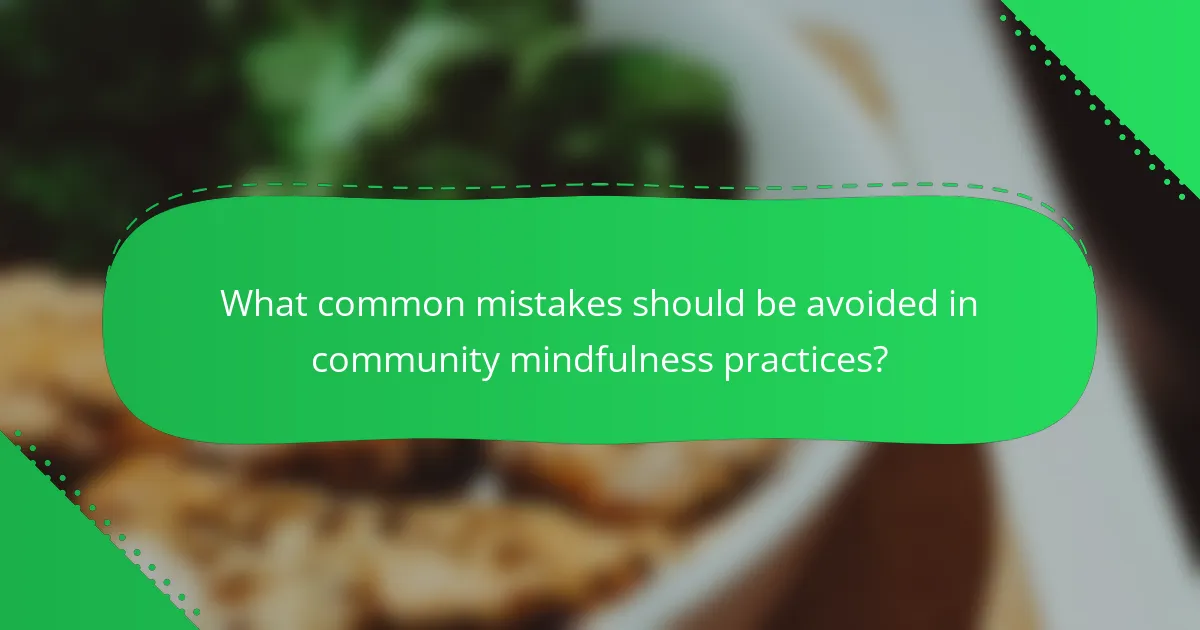
What common mistakes should be avoided in community mindfulness practices?
Common mistakes in community mindfulness practices include neglecting individual needs, failing to create a safe space, and overlooking group dynamics. Avoiding these pitfalls fosters deeper connections and enhances overall benefits.
1. Ignoring personal experiences can alienate participants. Each individual’s journey with mindfulness is unique and should be acknowledged.
2. Not establishing a supportive environment can hinder participation. A safe space encourages openness and trust among community members.
3. Overemphasizing structure can stifle creativity. Flexibility in practice allows for personal expression and adaptation to group needs.
4. Disregarding feedback may lead to disengagement. Regularly soliciting input helps tailor practices to better suit the community.
5. Focusing solely on outcomes can diminish the experience. Emphasizing the process of mindfulness promotes sustained engagement and enjoyment.
How can facilitators ensure effective communication during group sessions?
Facilitators can ensure effective communication during group sessions by fostering an open and inclusive environment. Encourage participants to share their thoughts and feelings, which enhances community support. Use mindfulness meditation techniques to promote active listening and empathy among group members. This approach helps in recognizing diverse perspectives, creating a sense of belonging, and strengthening social bonds. As a result, participants feel more connected and engaged, leading to more productive discussions.
What tips can enhance the effectiveness of mindfulness meditation in fostering community?
Mindfulness meditation can enhance community and social support by fostering connection, empathy, and shared experiences. Engaging in group meditation sessions encourages participants to bond over common goals, creating a sense of belonging.
Practicing active listening during meditation discussions cultivates empathy, allowing individuals to feel heard and understood. This shared vulnerability strengthens relationships and builds trust among community members.
Incorporating group activities, such as mindful walks or retreats, can deepen connections. These experiences create opportunities for participants to interact outside of traditional settings, reinforcing community ties.
Regularly sharing personal insights and experiences from meditation can encourage openness and support. This practice nurtures a culture of sharing that fosters a supportive environment, enhancing the overall effectiveness of mindfulness meditation in community building.
